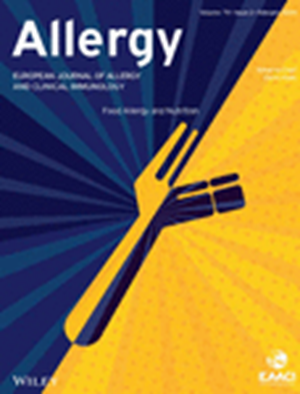Comparison of Allergic Rhinitis Treatments on Patient Satisfaction: A MASK-air and EAACI Methodological Committee Report.
IF 12
1区 医学
Q1 ALLERGY
引用次数: 0
Abstract
INTRODUCTION Satisfaction with treatments may affect medication adherence and use patterns, including the use of co-medication. We aimed to compare different medications for allergic rhinitis (AR) on (i) patients' satisfaction and (ii) co-medication use frequency. METHODS We assessed data from the mHealth app MASK-air. We evaluated days on which users with self-reported AR had used-alone or in co-medication-intranasal corticosteroids (INCS), intranasal antihistamines (INAH), fixed combinations of INAH+INCS, or oral antihistamines (OAH). We built multivariable regression models to compare these different AR medication classes (as well as individual medications) on their (i) treatment satisfaction levels (measured using a specific daily visual analogue scale ['VAS satisfaction']) and (ii) odds of being used in co-medication. RESULTS We assessed 28,177 days reported by 1691 MASK-air users. For all medication classes, co-medication usage was associated with lower treatment satisfaction. When used in monotherapy, OAH were associated with lower VAS satisfaction than INCS (-1.7 points; 95% CI = -2.7; -0.7) or INAH+INCS (-2.1 points; 95% CI = -3.5; -0.7). INCS displayed higher odds of being used in co-medication than OAH (OR = 1.3; 95% CI = 1.0; 1.6) or INAH+INCS (OR = 1.3; 95% CI = 0.8; 1.8). When comparing individual intranasal medications, fluticasone furoate and fluticasone propionate tended to be more frequently used in co-medication. Among individual OAH, desloratadine and rupatadine were associated with higher satisfaction, while fexofenadine was more frequently used in co-medication. CONCLUSION Using patient-reported data, we evaluated different medication classes and treatments in terms of satisfaction and co-medication frequency. These results provide key insights into the acceptability of AR treatments and will contribute to future treatment guidelines.变应性鼻炎治疗对患者满意度的比较:MASK-air和EAACI方法学委员会报告。
对治疗的满意度可能影响药物依从性和使用模式,包括联合用药的使用。我们的目的是比较不同的药物治疗过敏性鼻炎(AR)在(i)患者的满意度和(ii)共同用药频率。方法我们评估来自移动健康应用MASK-air的数据。我们评估了自我报告AR的使用者单独或联合使用鼻内皮质类固醇(INCS)、鼻内抗组胺药(INAH)、INAH+INCS的固定组合或口服抗组胺药(OAH)的天数。我们建立了多变量回归模型来比较这些不同的AR药物类别(以及个别药物)的(i)治疗满意度水平(使用特定的每日视觉模拟量表[“VAS满意度”]测量)和(ii)在联合用药中使用的几率。结果我们评估了1691名口罩使用者报告的28177天。对于所有药物类别,联合用药与较低的治疗满意度相关。当用于单药治疗时,OAH与INCS(-1.7分;95% CI = -2.7; -0.7)或INAH+INCS(-2.1分;95% CI = -3.5; -0.7)相关的VAS满意度较低。INCS联合用药的几率高于OAH (OR = 1.3; 95% CI = 1.0; 1.6)或INAH+INCS (OR = 1.3; 95% CI = 0.8; 1.8)。当比较单个鼻内药物时,糠酸氟替卡松和丙酸氟替卡松更常用于联合用药。在个体OAH中,地氯雷他定和鲁帕他定与更高的满意度相关,而非索非那定更常用于联合用药。结论根据患者报告的数据,我们对不同的用药类别和治疗方法的满意度和联合用药频率进行了评估。这些结果为AR治疗的可接受性提供了关键见解,并将有助于未来的治疗指南。
本文章由计算机程序翻译,如有差异,请以英文原文为准。
求助全文
约1分钟内获得全文
求助全文
来源期刊

Allergy
医学-过敏
CiteScore
26.10
自引率
9.70%
发文量
393
审稿时长
2 months
期刊介绍:
Allergy is an international and multidisciplinary journal that aims to advance, impact, and communicate all aspects of the discipline of Allergy/Immunology. It publishes original articles, reviews, position papers, guidelines, editorials, news and commentaries, letters to the editors, and correspondences. The journal accepts articles based on their scientific merit and quality.
Allergy seeks to maintain contact between basic and clinical Allergy/Immunology and encourages contributions from contributors and readers from all countries. In addition to its publication, Allergy also provides abstracting and indexing information. Some of the databases that include Allergy abstracts are Abstracts on Hygiene & Communicable Disease, Academic Search Alumni Edition, AgBiotech News & Information, AGRICOLA Database, Biological Abstracts, PubMed Dietary Supplement Subset, and Global Health, among others.
 求助内容:
求助内容: 应助结果提醒方式:
应助结果提醒方式:


